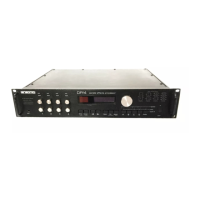Section 2 — Algorithms
98 ENSONIQ DP/4+ Reference Manual
07 — Envelope Follower to Pre VCF Range: -99 to +99
Determines how much the amplitude of the incoming signal will modify the distortion filter
cutoff frequency. When set to +00, no modification will occur. When set to mid positive values,
the Pre-Distortion VCF Fc will go high, but then come down to its nominal setting. When set to
negative mid values, the Pre-Distortion VCF Fc will go low, and then go back up to its nominal
setting. How quickly it does so is determined by parameters 11 and 12. This sound is the auto-
wah; positive values will boost the high frequencies, offering an “oww-oww” sound, and
negative values will cut the high frequencies, producing a “dweep-dweep” sound.
08 — Post-Distortion VCF Fc
09 — Post-Distortion VCF Q
10 — Envelope Follower to Post VCF
These three parameters are identical to the previous parameters, and are used to control the
second VCF that exists after the distortion.
11 — Envelope Follower Attack Range: 50µs to 10.0s
Sets the attack of the envelope follower (i.e. determines how closely the attack is followed) once
the incoming signal has been detected. Generally the attack should be short.
12 — Envelope Follower Release Range: 1ms to 10.0s
Sets the amount of time after the incoming signal has ceased for the envelope follower to shut
down. Generally these times are longer than the attack times.
13 — Distortion Bypass Range: Off or On
This parameter allows you to bypass the distortion (as shown on the signal routing diagram).
14 — Pre-EQ High Pass Cutoff Range: 0 to 1000 Hz
Filters out the low frequencies before the EQ. The higher the value, the less low frequencies will
pass through.
15 — Mod1 Source 19 — Mod2 Source
16 — Mod1 Destination 20 — Mod2 Destination
17 — Mod1 Param Range Min 21 — Mod2 Param Range Min
18 — Mod1 Param Range Max22 — Mod2 Param Range Max
See the descriptions under the Algorithm Modulators, found in the beginning of this section.

